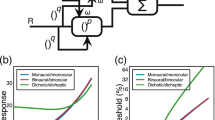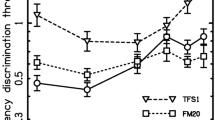Summary
The results of several experiments are reported which indicate: 1) complete auditory temporal summation for threshold of up to 32 msec for tones of 493, 1967, and 7874 Hz using a three-alternative forced-choice technique. 2) Equal-energy, equally detectable stimuli constructed of different intensities and durations within the range of complete integration are discriminable from one another. 3) Discrimination level increases as a function of the overall energy level and, consequently, as a function of detection level. 4) When discrimination level is plotted against detection level on normal-normal coordinates, the result is a straight line with a slope (b) greater than unity (1.41⩽b⩽1.68). 5) The extent of the discrimination capability, as well as the slope of the function relating discrimination level to detection level, was found to be independent of the frequency of the tone.
Similar content being viewed by others
References
Algom D, Babkoff H (1978) Discrimination of equal-energy, equally detectable auditory stimuli. Psychol Res 40:149–157
Allan LG, Kristoferson AB (1974) Psychophysical theories of duration discrimination. Percept Psychophys 16:26–34
Babkoff H, Sutton S (1971) Monaural temporal interactions. J Acoust Soc Am 50:459–465
Bruder GE, Kietzman ML (1973) Visual temporal integration for threshold signal detectability and reaction time measures. Percept Psychophys 13:293–300
Clark WC, Blackwell HR (1959) Relations between visibility thresholds for single and double pulses. Project Michigan Report 214–345
Efron R (1973) Conservation of temporal information by perceptual systems. Percept Psychophys 14:518–530
Garner WR (1947) The effect of frequency spectrum on temporal integration of energy in the ear. J Acoust Soc Am 19:808–815
Green DM (1971) Temporal auditory acuity. Psychol Rev 78:540–551
Green DM (1973) Temporal acuity as a function of frequency. J Acoust Soc Am 54:373–379
Grossberg M (1968) The latency of response in relation to Bloch's law at threshold. Percept Psychophys 4:229–232
Hawkins JE, Stevens SS (1950) The masking of pure tones and of speech by white noise. J Acoust Soc Am 22:6–13
Hunter WS, Sigler M (1940) The span of visual discrimination as a function of time and intensity of stimulation. J Exp Psychol 26:160–179
Kahneman D, Norman J (1964) The time-intensity relation of visual perception as a function of the observers's task. J Exp Psychol 68:215–220
Lewis MF (1967) Two-flash thresholds as a function of luminance in the dark-adapted eye. J Opt Soc Am 57:814–815
Patterson JH, Green DM (1970) Discrimination of transient signals having identical energy spectra. J Acoust Soc Am 48:536–553
Penner MJ (1978) A power law transformation resulting in a class of short-term integrators that produce time-intensity trades for noise bursts. J Acoust Soc Am 63:195–210
Raab DH, Fehrer E (1962) The effect of stimulus duration and luminance on visual reaction time. J Exp Psychol 64:326–327
Shower EG, Biddulph R (1931) Differential pitch sensitivity of the ear. J Acoust Soc Am 3:275–287
Wasserman GS, Kong K-L (1979) Absolute timing of mental activities. Behav Brain Sci 2:243–255
Watson CS, Gengel RW (1969) Signal duration and signal frequency in relation to auditory sensitivity. J Acoust Soc Am 46:989–997
Wright HN (1968) Clinical measurement of temporal auditory summation. J Speech Hearing Res 11:109–127
Zacks JL (1970) Temporal summation phenomena at threshold: Their relation to visual mechanisms. Science 170:197–199
Zwislocki JJ (1960) Theory of temporal auditory summation. J Acoust Soc Am 32:1046–1060
Author information
Authors and Affiliations
Additional information
All communications regarding this paper are to be addressed to Dr Harvey Babkoff. Dr Babkoff is spending the 1979–1980 academic year at the Military Medical Psychophysiology Laboratory of the Walter Reed Army Institute of Research, Washington, D.C., USA
This material has been reviewed by the Walter Reed Army Institute of Research, and there is no objection to its presentation and/or publication. The opinions or assertions contained herein are the private views of the authors and are not to be construed as official or as reflecting the views of the Department of the Army or the Department of Defense
Rights and permissions
About this article
Cite this article
Algom, D., Babkoff, H. & Ben-Uriah, Y. Temporal integration and discrimination of equally detectable, equal-energy stimuli: The effect of frequency. Psychol. Res 42, 305–318 (1980). https://doi.org/10.1007/BF00308727
Received:
Issue Date:
DOI: https://doi.org/10.1007/BF00308727




